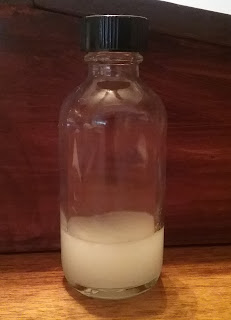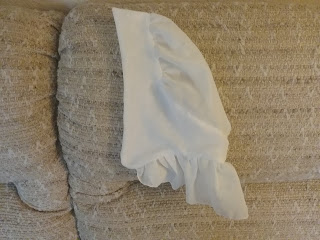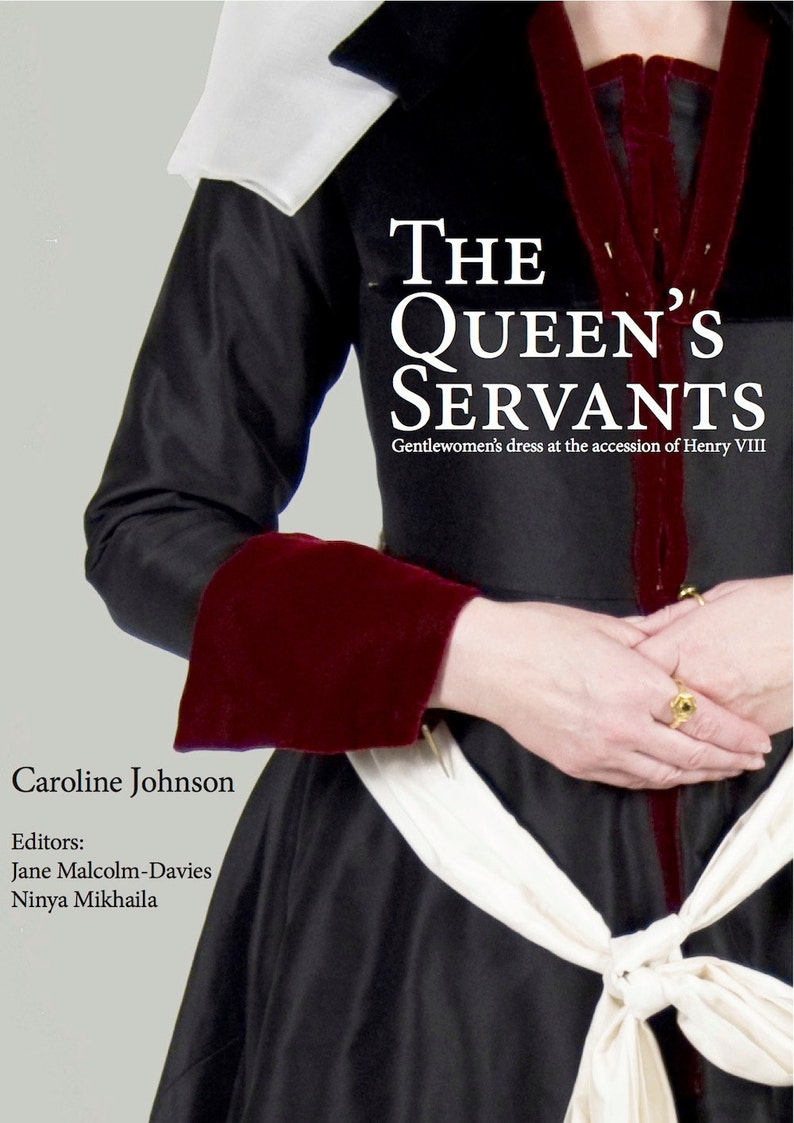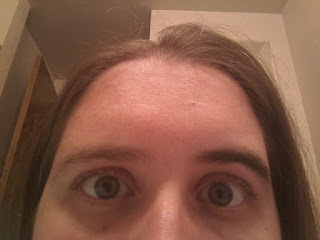 |
| Yay, a new old hand. |
Wednesday, October 31, 2018
Inktober 2018
Monday, October 29, 2018
Eau de Cologne (1859)
Another--French spirits of wine 1 J lbs, essence of bergamot 1 drachm, essence of lemon 1 drachm, English oil of lavender drachm, oil of juniper drachm, oil of neroli 2 scruples. Shake well together occasionally for two or three days when the mixture will be fit for use.Converting from the apothecary measures, that's a proportion of 288 parts spirits of wine: 3 parts bergamot : 3 lemon : 3 lavender : 3 juniper : 2 neroli. I used synthetic neroli scent oil, as the pure neroli (orange flower blossom) oil was cost prohibitive (~$60 for 1/8 oz).
 |
| Eau de Cologne, 1859 version. The oils aren't entirely miscible. |
As advised in the receipt, I've shaken the bottle every day. However, even after a week, it still tends to separate out into a pale yellow layer over a colorless layer. Mixing two not-wholly-mutually-miscible liquids, of course, produces the opaque white mixture seen above.
The scent, like the previous Eau de Cologne I prepared, is rather hard to describe. It's not quite the same, but both are 'greater than the sum of their parts'. Comparing the two, I'm tempted to describe this version as more floral and the first as more citrus-y, but that's far from a complete explanation.
Both receipts contain bergamot and lemon. The first one added lemon balm as well, and used orange flower water where the second had neroli (orange flower) oil. The second calls for lavender oil where the first used lavender-containing Hungary water. The largest difference by component is that this new version uses juniper oil where the first used rosemary (and rosemary-based Hungary water). The first also had traces of sage and thyme in the Hungary water.
Friday, October 26, 2018
Zombie Make Up
 |
| Or because I don't keep modern costume supplies on hand. |
Tuesday, October 23, 2018
Morning Cap, 1856
 |
| Cap, folded in half. |
Sunday, October 21, 2018
Original: Silk Round Gown c. 1795
 |
| The dress is great, but the staging also deserves love. More pictures at LACMA's online collection. |
And respect the dreadful nodding of that great plume!
Saturday, October 20, 2018
Hourglass Album Quilt, Interlude
In short, we think this autograph bedqullt may be called a very wonderful invention in the way of needlework. The mere mechanical part, the number of small pieces, stitches neatly taken and accurately ordered; the arranging properly and joining nicely 2780 delicate bits of various beautiful and costly fabrics, is a task that would require no small share of resolution, patience, firmness, and perseverance. Then comes the intellectual, part the taste to assort colors and to make the appearance what it ought to be, where so many hundreds of shades are to be matched and suited to each other. After that we rise to the moral, when human deeds are to live in names, the consideration of the celebrities, who are to be placed each, the centre of his or her own circle! To do this well requires a knowledge of books and life, and an instinctive sense of the fitness of things, so as to assign each name its suitable place in this galaxy of stars or diamonds.
--Godey's, April 1864
Thursday, October 18, 2018
Book Review: The Queen's Servants
 |
| The Queen's Servants by Caroline Johnson |
The link above gives a good overview of the book's content, so I'll keep the summary brief. The main differences between The Queen's Servants and The Tudor Tailor is the emphasis on analyzing original garment records: we're taking pie charts of color and material frequency, period yardage/pricing info, and hypothesized cutting lay-outs. Additionally, this book only looks at ladies' clothing* (there are separate volumes for men's and children's), and focuses on the earlier Tudor period (reign of Henry VII and early reign of Henry VIII). The illustrations include photographs of historic funerary monuments, artists' renderings of clothing from primary source texts, and photographs of reproduced garments. It runs 56 pages, including references and glossary.
[*Specifically, high-ranking women attached to the royal household: princesses, queens, the ladies and gentlewomen who attend them, and the occasional court pensioner.]
The description and analysis of primary sources deal with the fabrics and furs used for clothing, discussing the colors, yardage, prices, and customs. I like that the sources are very clearly cited, and that conjectures are explicitly described as such.
The given patterns are for one smock (with neckline variations), one kirtle (sleeve and fastener variations), two gowns (four sleeves and neckline variations), and two bonnets. The cutting patterns are given on grid paper, and will need to be sized to the wearer; general sewing instructions are also included, as well as marginalia showing relevant hand-sewing techniques. This isn't a beginner-friendly pattern, but I think it's quite clearly written, and would be usable by ambitious intermediate sewists. Beginners (and people who don't want to scale-up cutting diagrams) may want to consider the related pattern line.
The focus of this book is more narrow than The Tudor Tailor, but I think the discussion of primary sources really makes it worthwhile. If you're looking for lower class, mid/late 16th century, or men's clothing, this isn't the book you want. But for late 15th/early 16th century English noblewomen, you couldn't get a better reference.
Stars: 5
Accuracy: High.
Skill Level: Intermediate, tending Advanced
Strongest Impression: Good scholarship; the different time-frame makes it a companion to The Tudor Tailor rather than competition.
Monday, October 15, 2018
To Blacken the Eye Lashes and Eye Brows (1833-1854)
The Toilette of Health, Beauty and Fashion (Boston, 1833):
To Blacken the Eye lashes and Eye browsThis same receipt appears, verbatim, in The Book of Health and Beauty (London, 2nd edition 1837); it is also repeated in the The American Family Keepsake (Boston, 1849) and One Thousand Things Worth Knowing (New York, 1854). The Amateur (1851) mentions burned cork used as stage makeup.
The simplest preparations for this purpose are the juice of elder berries; burnt cork, or cloves burnt at the candle. Some employ the black of frankincense, resin, and mastic; this black, it is said, will not come off with perspiration.
So, does it work?
 |
| Burnt clove applied to my right eyebrow and lashes. I suspect there's no such thing as a flattering eyebrow selfie. |
 |
| And burnt cork, again on the right. |
Tuesday, October 2, 2018
Long and Short s
Monday, October 1, 2018
Book Review: Historical Costumes of England, 1066-1968
The costumes are organized by monarch. Since reigns can range from 2 years (Edward V/Richard III) to 67 years (Victoria), some of the shorter ones grouped together; as a the result, most book sections cover 20-40 years of English clothing. For each, there's a page of illustrations of men's clothing with a facing page of text, and another pair of pages on women's clothing. Some of the longer time spans get a second page of illustrations, while Victorian women's clothing is divided into three chronological parts (menswear gets one page of illustration with two of text).
Each page of illustrations generally contains eight sketched figures, although some have a dozen or more. I liked how the illustrations were of the clothing being worn, showing different styles on the body. The figures are loosely arranged in groups which hint of tableaux, so it looks contextual, a little more like real people, rather than diagrams
The downsides are that there's lots of material to cover, so most figures aren't full-length, and none have full front and back views (there are figures in profile). Only a few figures have specific dates attached, but the text gives some cues about earlier/later fashions within a reign, and briefly addresses the differences between old and young, or rich and poor. The images are detailed (and in some cases familiar), which suggests that particular historic sources were consulted, but no citation list or bibliography is included.
Due to scope, this book really functions best for survey purposes. It's really not specific enough to costume multiple characters for a particular year (especially getting into these later times when so much more information is available), but it is a quick start to acquaint your eye with the time. I could see it being a very useful first reference for theatrical costumers, or a visual guide for people working across multiple eras, but it's not in-depth enough to be very useful for most of the costuming I do.
Accuracy: Good, so far as I can tell, but more citations would be welcome.
Strongest Impression: A breadth book, rather than a depth one. It's good at what it does, but if you need color images or specific information, it's probably not your best choice.
